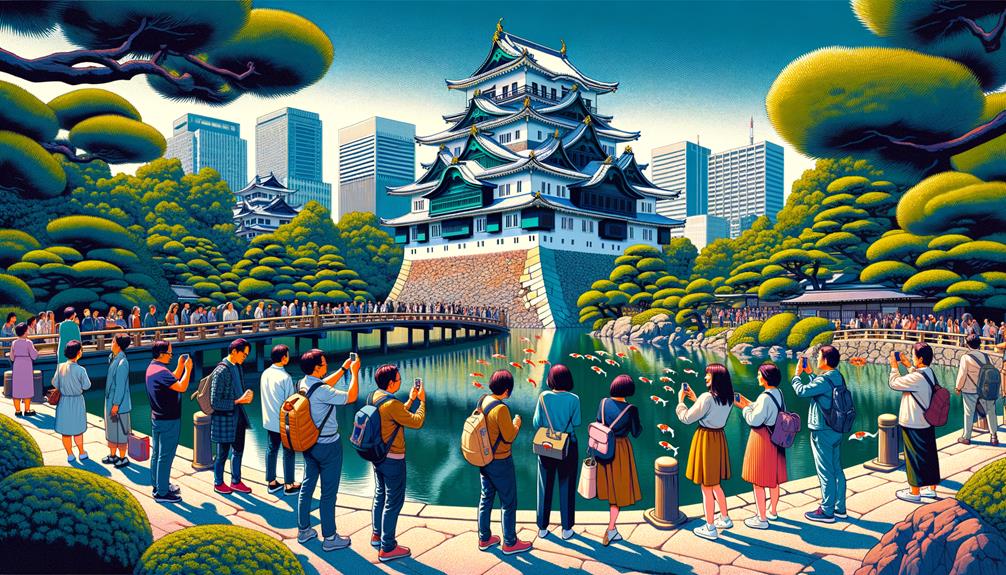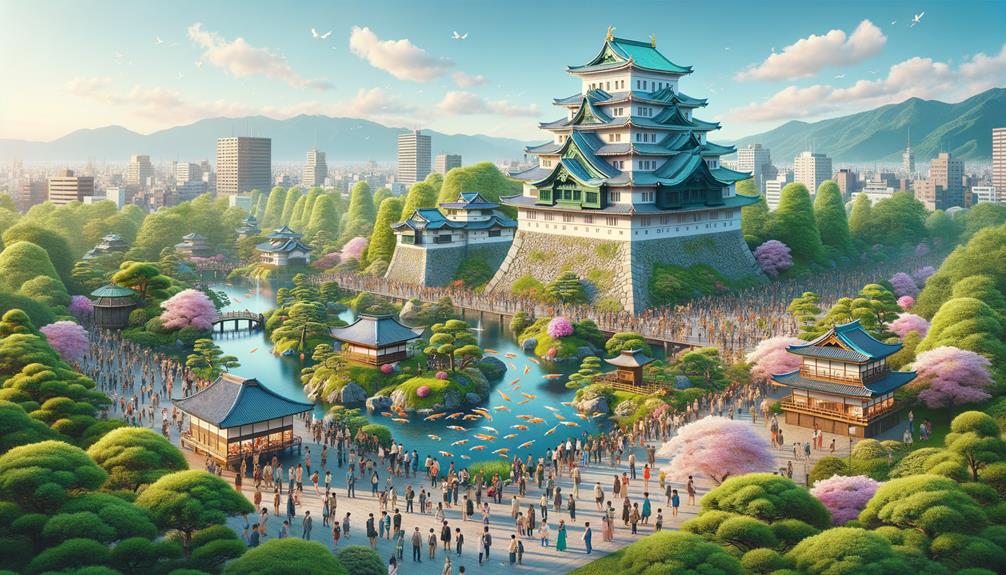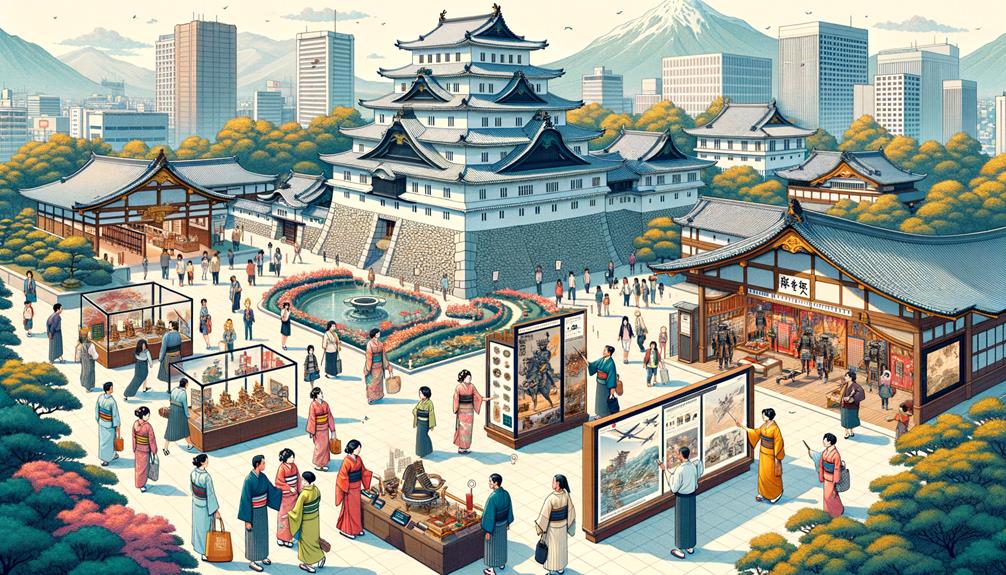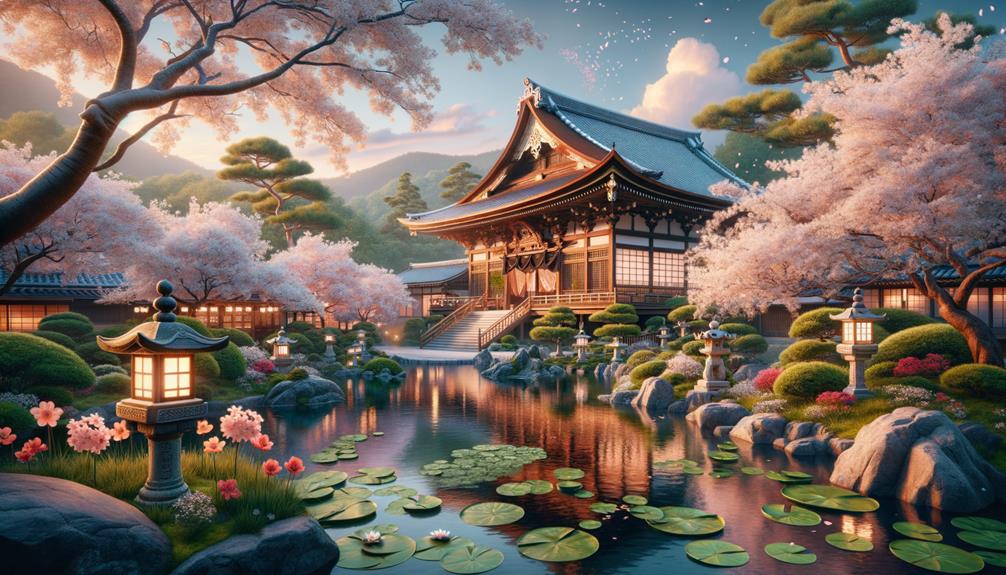Strolling through Nagoya Castle, I was struck by the mix of ancient and modern elements that define this historic site. The massive stone walls, remnants of the 17th-century fortress, stand as silent witnesses to a bygone era, while the ongoing wooden reconstruction of the main keep shows Japan's commitment to preserving its craftsmanship. Inside the Honmaru Palace, the intricate Shoin architecture and national treasures vividly depict feudal Japan. But what really piqued my interest was how these elements blend seamlessly with the surrounding beauty of Tokugawa-en and the spiritual atmosphere of Atsuta Shrine. There was something else that really caught my eye…
Location and Access
Tucked away in the bustling heart of Nagoya, Nagoya Castle is a historic marvel that's surprisingly easy to visit. When I made my way there, I found the journey refreshingly simple. Traveling from Tokyo or Osaka, the bullet train whisked me to Nagoya Station in just about an hour. With a JR rail pass, the ride was included, making the trip both quick and budget-friendly.
From Nagoya Station, I took the subway to Shiyakusho Station using the Meijo Line. A short and pleasant walk from there brought me right to the castle grounds. The ease of this route is perfect for anyone wanting to soak in the city's rich culture without the hassle. The convenience of this journey really can't be overstated, as it allows for a thorough and relaxed visit.
Once there, I found out about the combined ticket option, which covers entry to Nagoya Castle and nearby spots like Tokugawa-en. This provides a full cultural experience right in the city's vibrant center. Thanks to its central location and excellent access points, Nagoya Castle is a must-visit for anyone interested in Japan's historical sites.
Attractions and History

Walking through the gates of Nagoya Castle, I was immediately struck by the grandeur and historical significance of this 17th-century fortress. The original stone walls loomed above, a reminder of the Tokugawa clan's power and strategic importance. As I strolled through the grounds, I felt a profound connection to Japan's feudal history.
Honmaru Palace, with its stunning Shoin architecture, stood out as a highlight of the castle complex. Inside, I was captivated by the national treasures that recounted an era where art and warfare coexisted. The meticulous attention to detail in the palace's wood reconstruction was impressive, capturing the spirit of its original craftsmanship.
Although the main keep is currently being reconstructed, with plans to complete it in wood by October 2028, the ongoing work only added to the castle's historical value. It's a living monument, constantly evolving yet deeply rooted in the past.
Outside the castle walls, nearby attractions like Tokugawa-en, Atsuta Shrine, and Osu Kannon Temple offered their own unique glimpses into the region's rich cultural heritage. Each site complemented the history within Nagoya Castle, making my visit a truly enriching journey through time.
Visitor Experience

Visiting Nagoya Castle and the Honmaru Palace was a journey steeped in history and beauty. The castle's imposing presence speaks volumes about Japan's storied past, while the traditional Shoin architecture of the Honmaru Palace offers a window into the nation's cultural heritage.
Walking through the palace, I was captivated by the national treasures displayed throughout. Each artifact had its own story, and the strict authenticity guidelines enhanced the experience, making me feel transported back in time. The historical significance was particularly evident in the carefully reconstructed rooms.
The ongoing project to rebuild the Honmaru Palace, which began 60 years after the castle's initial restoration, aims to faithfully recreate these historical rooms. Watching the first stage of this work was fascinating; the attention to detail was remarkable. It was clear that every effort was made to honor the original designs and methods. This dedication offered a deep appreciation for the craftsmanship involved. My visit to Nagoya Castle was a memorable dive into history that I will always treasure.
Nearby Attractions

To truly appreciate Nagoya's rich cultural heritage, you should explore the nearby attractions that enhance the grandeur of Nagoya Castle. Just a short walk away, Tokugawa-en offers a peaceful retreat with its beautifully landscaped gardens, while the Tokugawa Art Museum showcases Japanese history through its exquisite collections. These cultural sites give you a deeper understanding of the historical era that shaped Nagoya Castle.
A visit to Atsuta Shrine, one of Japan's most revered Shinto shrines, adds a spiritual dimension to your journey. Its ancient artifacts and sacred atmosphere make it a must-see. Similarly, Osu Kannon Temple, with its vibrant market streets and rich religious significance, offers a mix of tranquility and lively local culture.
For a taste of modernity, head to the Sakae District. This bustling area, filled with shopping, entertainment, and dining options, contrasts beautifully with the historical sites. The combination of Nagoya Castle's historical splendor with these diverse attractions provides a well-rounded and enriching experience. It's a journey through time, seamlessly blending Japan's past and present.
Additional Services

Nagoya offers a range of services that make exploring the city exciting and memorable. From guided tours to adventure packages, and knowledgeable local guides, there's something for everyone. When you visit Nagoya Castle, these services provide added depth and excitement to your visit. The local guides share insider tips and offer personalized tours to ensure you uncover all the hidden gems.
Subscribing to the newsletter is another great way to enhance your trip. It provides travel tips, insights into lesser-known spots, and exclusive content you won't find elsewhere. The adventure packages are especially thrilling, offering unique experiences that will stay with you long after you leave.
Social media platforms like Facebook, Twitter, Instagram, and TikTok keep you updated with travel tips and community engagement, making your visit even more interactive. Here's a quick overview of what you can expect:
| Service | Highlights | Benefits |
|---|---|---|
| Guided Tours | Insider knowledge | Personalized tours |
| Adventure Packages | Unique experiences | Thrilling explorations |
| Local Guides | Deep insights | Hidden gems revealed |
| Newsletter Subscription | Travel tips & exclusive content | Enhanced trip planning |
Frequently Asked Questions
Is Nagoya Castle Worth Visiting?
For sure, Nagoya Castle is a must-visit. The history and ongoing restoration efforts caught my interest. The treasures inside the Honmaru Palace and the peaceful surroundings made the visit really special. Plus, at just 500 yen, it's quite affordable.
How Long Do You Need at Nagoya Castle?
When I visited Nagoya Castle, I spent about 2.5 hours soaking in its history and admiring the beautiful architecture. If you want to get the full experience, I'd say plan for at least 2 hours. It's definitely worth your time.
Why Is Nagoya Castle Important?
Nagoya Castle holds a special place in Japanese history as a key stronghold for the Tokugawa shogunate. Its beautiful Edo-era architecture is a testament to that period's craftsmanship. The ongoing reconstruction efforts aim to restore its historical and cultural significance, reflecting Japan's rich heritage and resilience over the centuries.
What Is a Fun Fact About Nagoya Castle?
You might think castles are just stone and history, but Nagoya Castle stands out with its golden dolphins, or shachihoko, on the roof. These mythical creatures are believed to offer protection and are a distinctive part of the skyline, especially when lit up at night.



